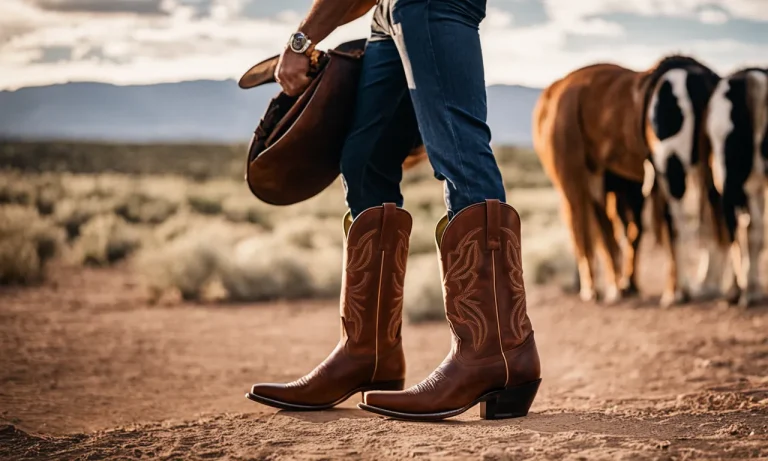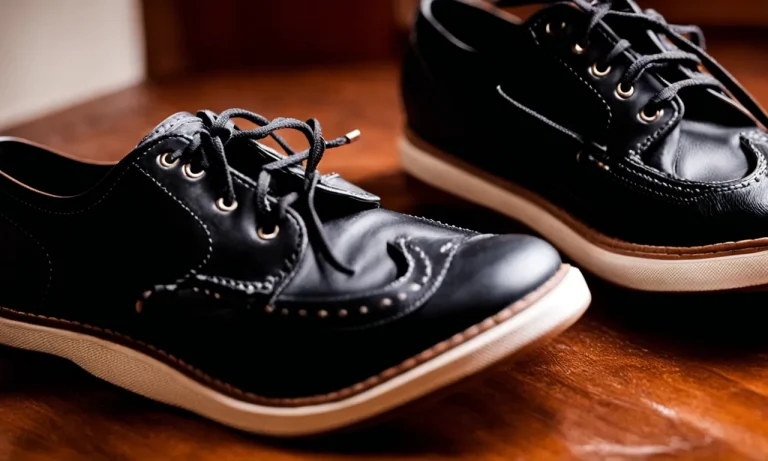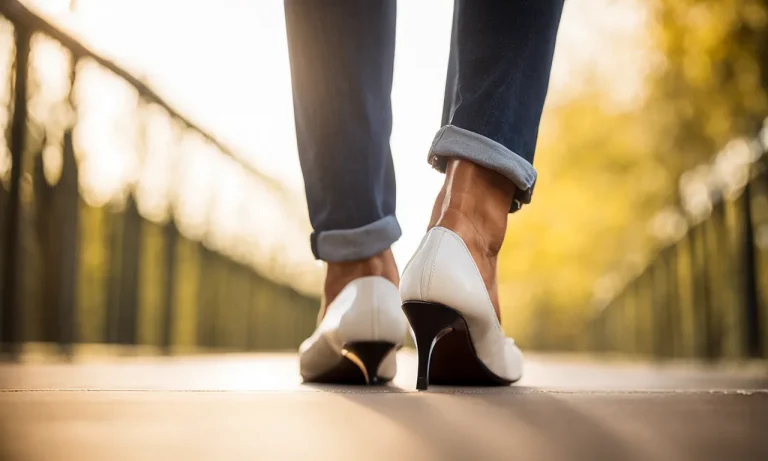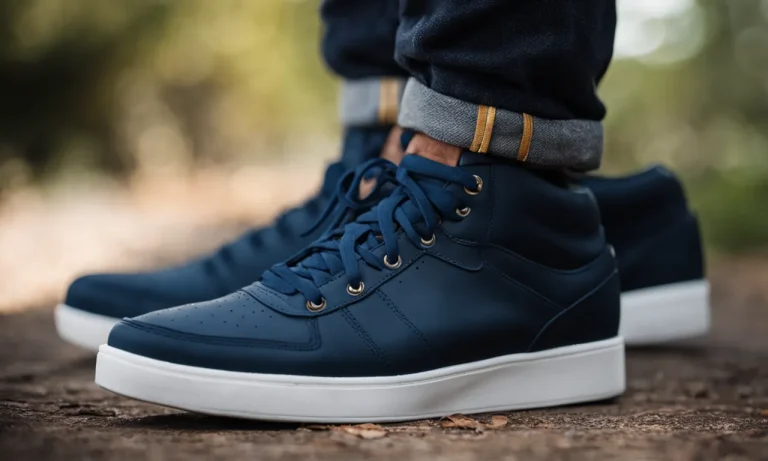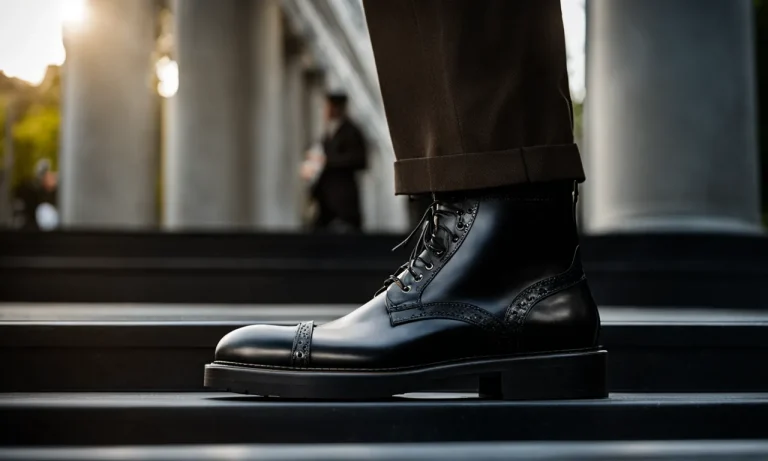Finding the perfect fitting shoe can be tricky. If your shoes are too small, it can lead to discomfort, pain, and potential injuries. But how do you know for sure if a shoe is too small for your feet?
If you’re short on time, here’s a quick answer to your question: Look out for signs of tightness across the widest part of your foot, cramping in the toes, and rub marks on the skin. You should have about a thumbs width between your longest toe and the end of the shoe.
In this comprehensive guide, we will cover everything you need to know about determining if your shoes are too small. We’ll discuss common signs to look for when trying on shoes, how to measure your feet properly, factors that can affect fit, and tips for finding the right shoe size.
Signs that Your Shoes May Be Too Small
Tightness or Pressure Across the Ball of Your Foot
If you feel tightness or pressure across the ball of your foot when you put on your shoes, it may be a sign that they are too small. This can happen because your toes are being squeezed together in a narrow toe box.
The pressure can cause discomfort and make it difficult to walk or stand for long periods of time.
Cramped, Curled Toes
Another sign that your shoes may be too small is if your toes feel cramped and curled up inside the shoe. This can happen when there is not enough room for your toes to spread out naturally. Cramped toes can lead to foot pain and even deformities such as bunions or hammertoes over time.
Rub Marks and Red Areas
If you notice rub marks or red areas on your feet after wearing your shoes, it could be a sign that they are too small. These marks are caused by friction between your foot and the shoe. Shoes that are too small can cause blisters, calluses, or irritation on the skin.
Overhang of the Big Toe
One way to determine if your shoes are too small is to check if your big toe is hanging over the edge of the shoe. If it is, then the shoe is not providing enough space for your foot. This can lead to discomfort and make it difficult to walk or run.
Pain in the Ball of Your Foot
If you experience pain in the ball of your foot, it could be a sign that your shoes are too small. When your shoes are too tight, they can put pressure on the metatarsal bones in the ball of your foot, causing pain and discomfort.
Numbness or Tingling in the Toes
Feeling numbness or tingling in your toes after wearing your shoes for a while may indicate that they are too small. When your shoes are too tight, they can compress the nerves in your feet, leading to these sensations.
It’s important to pay attention to these signs and make sure your shoes fit properly. Wearing shoes that are too small can lead to foot problems and discomfort. If you’re unsure about the fit of your shoes, consider getting a professional fitting or trying on a larger size. Your feet will thank you!
Measuring Your Feet Correctly
When it comes to finding the perfect fit for your shoes, measuring your feet correctly is crucial. Here are a few methods to ensure accurate measurements:
Use a Brannock Device
A Brannock Device is a specially designed measuring tool that can accurately measure both the length and width of your feet. It provides precise measurements and takes into account the arch length as well.
Most shoe stores have a Brannock Device, so don’t hesitate to ask for assistance from a salesperson.
Trace Your Foot and Measure It
If you don’t have access to a Brannock Device, you can trace your foot on a piece of paper and measure it yourself. Place your foot on the paper, ensuring it is flat against the surface, and trace around it.
Then, using a ruler, measure the length from the heel to the longest toe and the width at the widest part of the foot. Compare these measurements to a shoe size chart to determine your correct size.
Measure Both Feet and in the Evening
It’s important to measure both of your feet as they can vary in size. Use the larger measurement as your reference when selecting shoes. Additionally, feet tend to swell throughout the day, so it is recommended to measure them in the evening when they are at their largest.
This will help ensure a comfortable fit even during long periods of wear.
Measure Width as Well as Length
Many people focus solely on the length when measuring their feet, but the width is just as important. A shoe that is too narrow can cause discomfort and lead to various foot problems. To measure the width, use a tape measure or a piece of string and wrap it around the widest part of your foot.
Compare this measurement to the available width options in shoe sizes to find the best fit.
Remember, finding the right shoe size is not only about comfort but also about maintaining the health of your feet. By measuring your feet correctly and considering both length and width, you can ensure that your shoes fit properly and support your feet throughout the day.
Factors Affecting Shoe Fit
When it comes to finding the perfect fit for your shoes, there are several factors that can affect how comfortable they feel on your feet. Understanding these factors can help you determine if a shoe is too small and avoid potential foot problems down the line.
Foot Shape and Dimensions
One of the most crucial factors in determining shoe fit is your foot shape and dimensions. Feet come in various shapes and sizes, and different shoe styles cater to different foot types. Some people have wider feet, while others have narrower feet.
Understanding your foot shape and dimensions can help you choose the right shoe size and width.
👍 Pro Tip: If you have wider feet, look for shoes with a wider toe box to ensure a comfortable fit.
Sock Thickness
The thickness of the socks you wear can also impact how a shoe fits. Thicker socks can make your shoes feel tighter, while thinner socks can create more room inside the shoe. When trying on shoes, it’s a good idea to wear the type of socks you would typically wear with that particular shoe to get an accurate feel for the fit.
Intended Activity
The intended activity for which you are purchasing the shoes can also affect the fit. Different activities require different levels of support and flexibility. For example, running shoes typically have more cushioning and a different fit compared to hiking boots or dress shoes.
Consider the specific demands of the activity you plan to engage in and choose a shoe that provides the necessary support and comfort.
Shoe Brand Sizing
It’s important to note that shoe sizes can vary between different brands. A size 8 in one brand may fit differently from a size 8 in another brand. To ensure a proper fit, it’s recommended to try on shoes from different brands and pay attention to how they feel on your feet.
💡 Did you know? Some shoe brands provide sizing charts on their websites, which can help you determine the best size to order online. Nike’s size and fit guide is a great resource for finding the right fit for their shoes.
Fit of Other Shoes You Own
If you already own shoes that fit well, you can use them as a reference point when trying on new shoes. Pay attention to the size and fit of the shoes you already own and compare them to the new ones you are trying on.
This can give you a better idea of whether a shoe is too small or too big for your feet.
By considering these factors and taking the time to properly assess the fit of your shoes, you can ensure that your feet stay comfortable and healthy. Remember, a shoe that is too small can lead to various foot problems, so it’s essential to find the right fit for your feet.
Tips for Finding the Right Shoe Size
When it comes to buying shoes, finding the right size is crucial for comfort and foot health. Here are some helpful tips to ensure you get the perfect fit:
Try Shoes On at the End of the Day
It’s a well-known fact that our feet tend to swell throughout the day. By trying on shoes at the end of the day, when your feet are at their largest, you can ensure that the shoes won’t feel tight or uncomfortable when you wear them for extended periods of time.
Walk Around the Store with Them On
Don’t just stand still when trying on shoes – take them for a test walk! Walking around the store will give you a better idea of how the shoes feel and fit. Pay attention to any areas of discomfort or tightness, as this can be a sign that the shoes are too small.
Buy For the Larger Foot
It’s not uncommon for one foot to be slightly larger than the other. When purchasing shoes, always choose a size that fits the larger foot. This will prevent any discomfort or pain caused by shoes that are too tight on one foot.
Consider Going Up a Half or Full Size
If you find that your toes are constantly cramped or your feet feel restricted in a particular shoe size, it may be time to size up. Going up a half or full size can provide the extra room your feet need, ensuring a more comfortable fit.
Choose Shoes with Adjustable Fastenings
Shoes with adjustable fastenings, such as straps or laces, are a great option for those with feet that are in between sizes. These types of shoes allow you to customize the fit to your liking, ensuring a comfortable and secure feel.
Consider Shoe Stretchers or Expanders
If you have a pair of shoes that are slightly too small, you may be able to stretch them out using a shoe stretcher or expander. These tools can help to gradually increase the size of the shoe, providing a more comfortable fit over time.
Remember, finding the right shoe size is essential for both comfort and foot health. By following these tips, you can ensure that your shoes fit properly and keep your feet happy.
Conclusion
Finding a properly fitting shoe is essential for comfort and foot health. Don’t ignore the signs that your shoes are too small – cramped toes, rub marks, and foot pain are your body’s way of indicating it’s time to size up.
Take the time to measure both feet and try shoes on at the end of the day when your feet are largest. Shop for styles with adjustable closures and consider sizing up, especially if you plan to use shoe inserts. With the right fit, your feet will thank you.

